Did Oracle Team USA Cheat to win the 34th America’s Cup?
Published on March 6th, 2016
by Craig Leweck, Scuttlebutt
Despite all the drama that surrounded the 34th America’s Cup – the cheating scandal, the jury rulings, the remarkable series – I figured we’d all moved on. It’s been two and half years. Stick a fork in it, right? Apparently not.
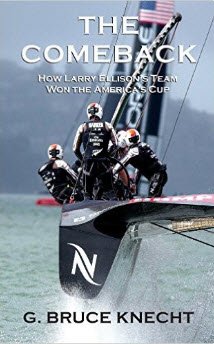 The release of a new book by G. Bruce Knecht, The Comeback, focuses on how the defender Oracle Team USA, seriously in a 1-8 hole, found new speed to win eight straight races to beat challenger Emirates Team New Zealand 9-8. And how they did it by cheating.
The release of a new book by G. Bruce Knecht, The Comeback, focuses on how the defender Oracle Team USA, seriously in a 1-8 hole, found new speed to win eight straight races to beat challenger Emirates Team New Zealand 9-8. And how they did it by cheating.
While Knecht details many of the changes made by the defender, one area gets the most attention. The defender got on a roll when they improved their upwind speed, a result of their ability to foil. But it was how they were able to foil is the big reveal. The book reports it was a result of rapidly pumping the main wing. Here’s an excerpt:
After every turn (tack), the frenzied in an out movements of the wing enabled the boat to rapidly climb up onto the foils. With the boat mostly liberated from the water’s grip, Oracle quickly gained ground on the Kiwis. Thanks to the continued pumping, Spithill could then turn slightly back toward the source of the wind to put the boat on a more direct course toward the next mark without falling off the foils. Nonstop pumping was crucial. “If we didn’t pump the wing, we would lose ground,” Spithill explained.
The book contends that Oracle Team USA won the 34th America’s Cup by cheating. That would normally be the case, however, this is the America’s Cup where the rules were different.
The Racing Rules of Sailing (RRS) had been modified for the America’s Cup, with significant changes made to Rule 42 – the propulsion rule – which is the section of the RRS that governs actions like pumping. It is this difference in the two versions of the rule that would appear to have relevance.
Under the America’s Cup edition, the rule states only that “A yacht shall compete only by using the wind and water to increase, maintain or decrease her speed. Her crew may adjust the trim of the wing, sails, rudders, daggerboards and hulls, and perform other acts of seamanship.”
That’s all it says, which to me means that you can’t use paddles to row the boat, or perhaps have crew with swim fins try to pull the boat. But you could use the items listed to their limits to sail the boat. Additionally, the Definitions in the America’s Cup edition make no mention of what it means to ‘trim’ the wing and sails.
What would appear significant is how in the RRS used by the sport, Rule 42 is much different. While the basic tenet is the same as the America’s Cup edition, the RRS also includes a list of exceptions and prohibited actions.
Rules only get more complicated when needed, so in the case of RRS Rule 42, clever people over time had pushed the limits of the basic rule to the point that specific techniques had to be listed as either allowed, allowed with limits, or banned.
One of those actions is pumping. In RRS Rule 42, it states that repeated fanning of any sail by pulling in and releasing the sail was prohibited. But the America’s Cup edition makes no specific mention of sail pumping, only saying that you can adjust the trim of the wing and sails during the race.
So do you think what Oracle Team USA did was permitted by the rules?
Video replay of the races here. Purchase the book here.
Racing Rules of Sailing – America’s Cup Edition (September 2013)
Rule 42
PROPULSION
A yacht shall compete only by using the wind and water to increase, maintain or decrease her speed. Her crew may adjust the trim of the wing, sails, rudders, daggerboards and hulls, and perform other acts of seamanship.
Racing Rules of Sailing – 2013-16
Rule 42
42.1 Basic Rule
Except when permitted in rule 42.3 or 45, a boat shall compete by using only the wind and water to increase, maintain or decrease her speed. Her crew may adjust the trim of sails and hull, and perform other acts of seamanship, but shall not otherwise move their bodies to propel the boat.
42.2 Prohibited Actions
Without limiting the application of rule 42.1, these actions are prohibited:
(a) pumping: repeated fanning of any sail either by pulling in and releasing the sail or by vertical or athwartship body movement;
(b) rocking: repeated rolling of the boat, induced by
(1) body movement,
(2) repeated adjustment of the sails or centreboard, or
(3) steering;
(c) ooching: sudden forward body movement, stopped abruptly;
(d) sculling: repeated movement of the helm that is either forceful or that propels the boat forward or prevents her from moving astern;
(e) repeated tacks or gybes unrelated to changes in the wind or to tactical considerations.
42.3 Exceptions
(a) A boat may be rolled to facilitate steering.
(b) A boat’s crew may move their bodies to exaggerate the rolling that facilitates steering the boat through a tack or a gybe, provided that, just after the tack or gybe is completed, the boat’s speed is not greater than it would have been in the absence of the tack or gybe.
(c) Except on a beat to windward, when surfing (rapidly accelerating down the front of a wave) or planing is possible, the boat’s crew may pull in any sail in order to initiate surfing or planing, but each sail may be pulled in only once for each wave or gust of wind.
(d) When a boat is above a close-hauled course and either stationary or moving slowly, she may scull to turn to a closehauled course.
(e) If a batten is inverted, the boat’s crew may pump the sail until the batten is no longer inverted. This action is not permitted if it clearly propels the boat.
(f) A boat may reduce speed by repeatedly moving her helm.
(g) Any means of propulsion may be used to help a person or another vessel in danger.
(h) To get clear after grounding or colliding with a vessel or object, a boat may use force applied by her crew or the crew of the other vessel and any equipment other than a propulsion engine. However, the use of an engine may be permitted by rule 42.3(i).
(i) Sailing instructions may, in stated circumstances, permit propulsion using an engine or any other method, provided the boat does not gain a significant advantage in the race.


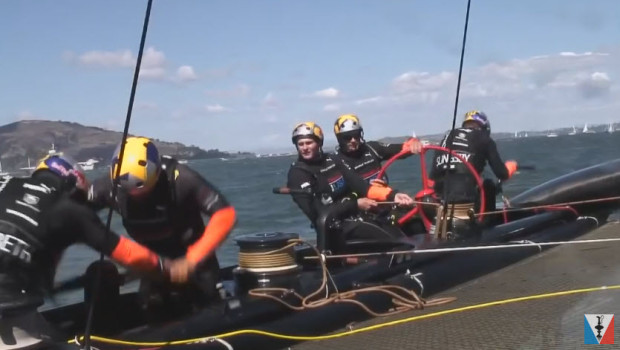


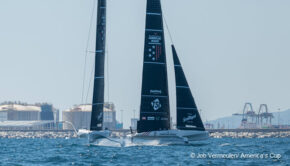
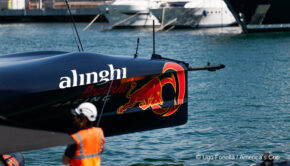

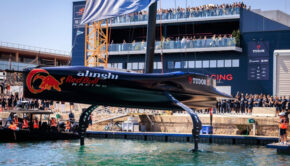
 We’ll keep your information safe.
We’ll keep your information safe.